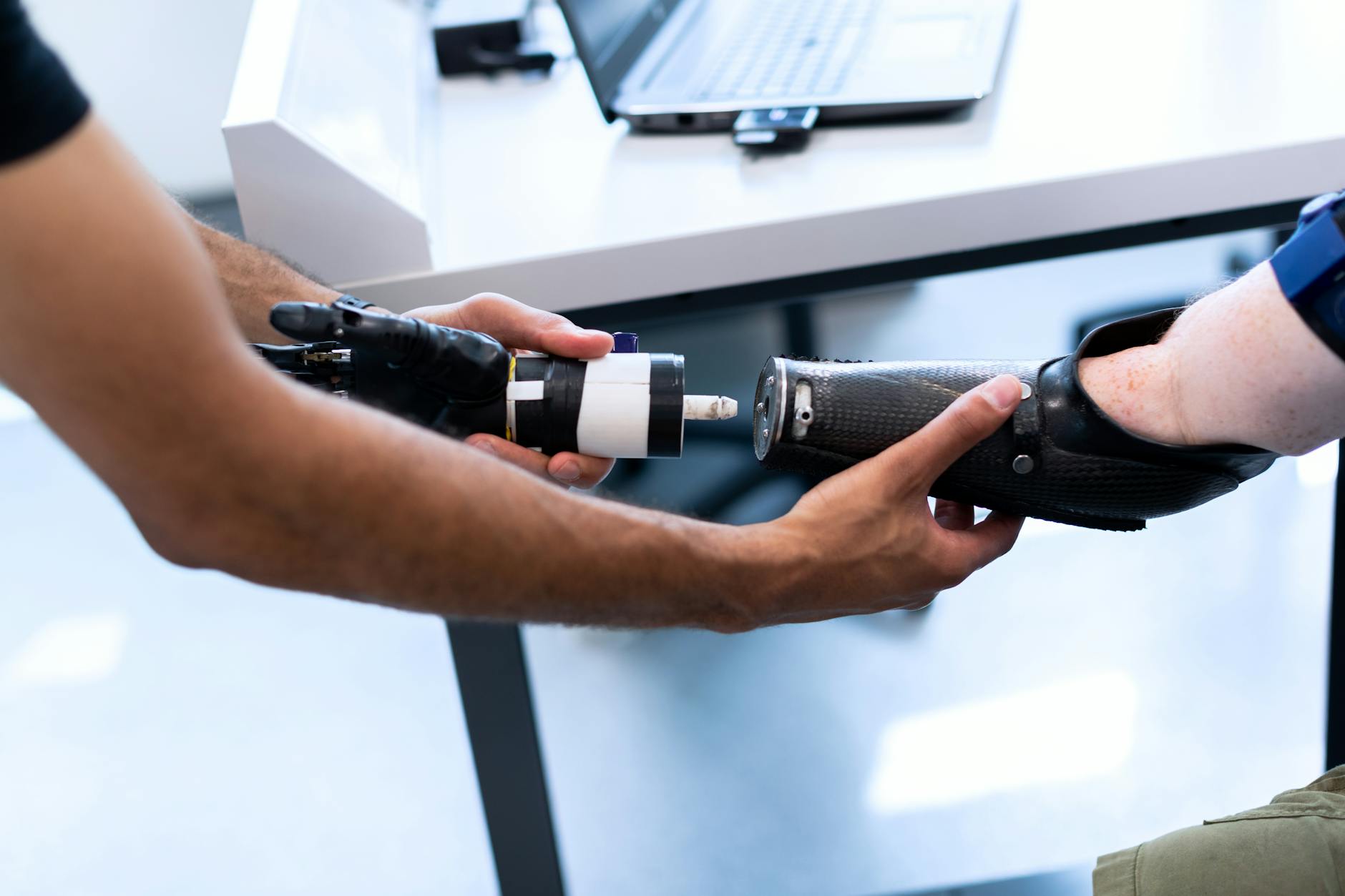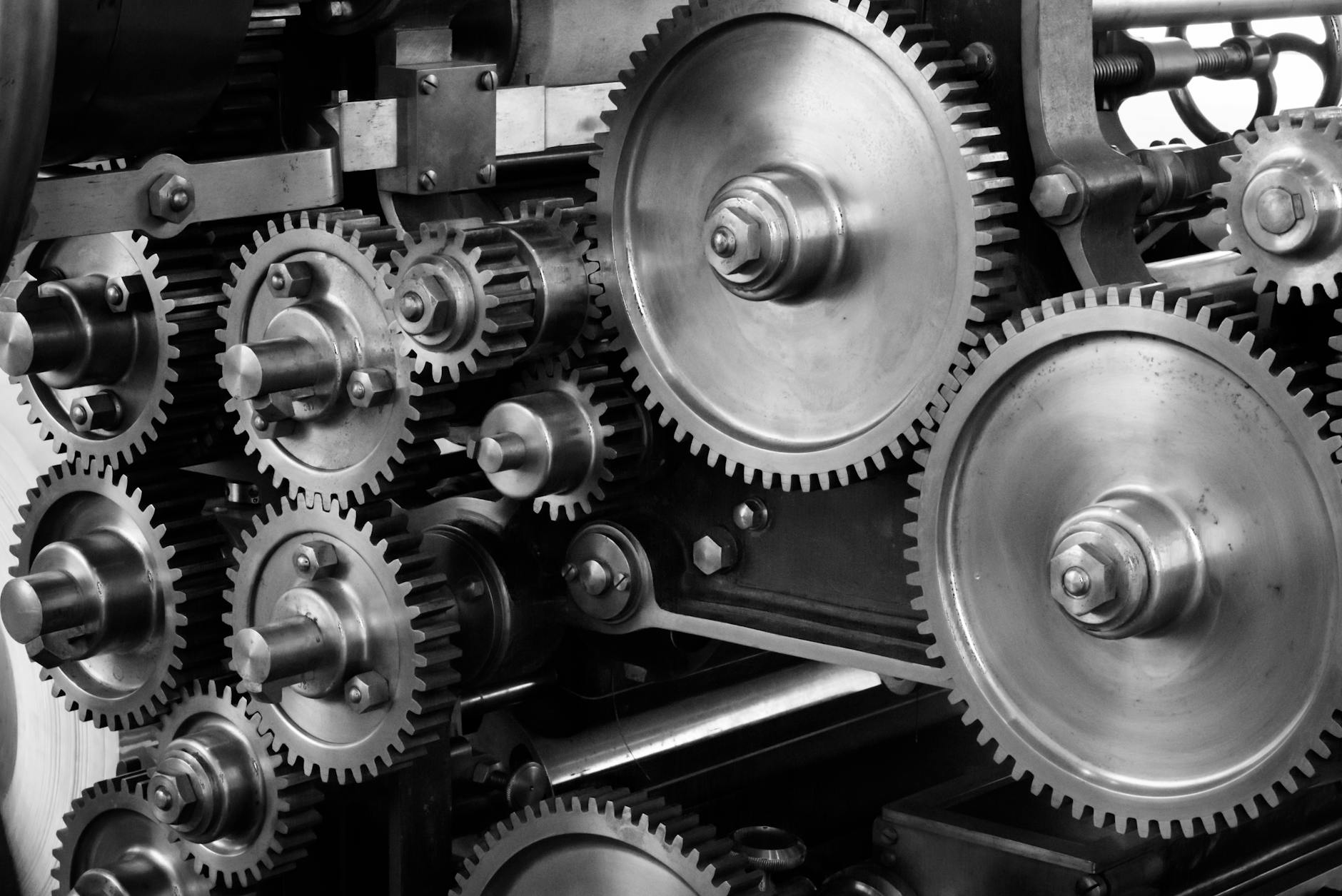
🤖 Beep boop … Is that the sound of your job being taken over by a robot?
The Future Of Automation In The Workplace :
In a world where technology is advancing at breakneck speed, the workplace as we know it is undergoing a massive transformation. Automation, once a distant concept from science fiction, is now knocking on the doors of offices and factories worldwide. But what does this mean for you and your career?
The rise of artificial intelligence, machine learning, and robotics is reshaping industries faster than ever before. While this technological revolution promises increased efficiency and productivity, it also raises concerns about job security and the future of human labor. Are we facing a jobless future, or are we on the brink of an exciting new era of work? As we delve into the future of work and how automation is shaping the workforce, we’ll explore the challenges, opportunities, and strategies for thriving in this rapidly evolving landscape.

The Rise of Workplace Automation
As we delve into the future of work, it’s crucial to understand the current landscape of workplace automation. This transformative technology is reshaping industries and redefining how we approach productivity and efficiency.
Current trends in automation adoption
Automation adoption is accelerating across various sectors, with businesses increasingly recognizing its potential to streamline operations and boost productivity. Some key trends include:
-
- Robotic Process Automation (RPA) for repetitive tasks
-
- AI-powered chatbots for customer service
-
- Machine learning algorithms for data analysis and decision-making
Industries most affected by automation
While automation impacts virtually every sector, some industries are experiencing more significant changes:
| Industry | Automation Impact |
|---|---|
| Manufacturing | High (robotics, assembly lines) |
| Finance | Moderate to High (algorithmic trading, fraud detection) |
| Healthcare | Moderate (diagnostic tools, patient monitoring) |
| Retail | Moderate (inventory management, self-checkout) |
| Transportation | High (self-driving vehicles, logistics optimization) |
Benefits of automation for businesses
Automation offers numerous advantages for companies:
-
- Increased efficiency and productivity
-
- Reduced operational costs
-
- Improved accuracy and consistency
-
- Enhanced safety in hazardous environments
-
- 24/7 operational capability
Potential job displacement concerns
While automation brings many benefits, it also raises concerns about job displacement. Some roles may become obsolete, requiring workers to adapt and acquire new skills. However, it’s important to note that automation often creates new job opportunities in emerging fields related to technology and automation management.
As we explore the impact of automation on the workforce, it’s essential to consider how artificial intelligence and machine learning are specifically shaping the modern workplace.

AI and Machine Learning in the Workplace
As we delve deeper into the future of work, it’s crucial to explore how AI and machine learning are reshaping the workplace landscape. These technologies are not just buzzwords; they’re driving significant changes in how businesses operate and make decisions.
How AI is revolutionizing decision-making
AI is transforming decision-making processes by:
-
- Analyzing vast amounts of data quickly
-
- Identifying patterns and trends humans might miss
-
- Providing data-driven insights for strategic planning
Machine learning applications in various sectors
| Sector | Machine Learning Application |
|---|---|
| Healthcare | Disease diagnosis and treatment prediction |
| Finance | Fraud detection and risk assessment |
| Retail | Personalized product recommendations |
| Manufacturing | Predictive maintenance and quality control |
Augmenting human capabilities with AI
AI and machine learning are not replacing humans but enhancing their capabilities:
-
- Automating repetitive tasks
-
- Providing real-time data analysis
-
- Enabling more informed decision-making
-
- Freeing up time for creative and strategic work
Ethical considerations of AI in the workforce
As AI becomes more prevalent, we must address important ethical questions:
-
- Data privacy and security
-
- Algorithmic bias and fairness
-
- Transparency in AI decision-making
-
- Job displacement and reskilling needs
With these considerations in mind, organizations must carefully navigate the integration of AI and machine learning to harness their benefits while mitigating potential risks. Next, we’ll explore how robotics and physical automation are further transforming the workplace.

Robotics and Physical Automation
As we delve deeper into the realm of workplace automation, it’s crucial to explore the significant impact of robotics and physical automation on various industries. This technology is reshaping the way we work and interact with machines in unprecedented ways.
Advancements in robotic technology
Recent years have witnessed remarkable progress in robotic technology, with machines becoming more sophisticated, versatile, and intelligent. Some key advancements include:
-
- Improved sensors and perception systems
-
- Enhanced artificial intelligence and machine learning capabilities
-
- More dexterous and precise robotic arms and grippers
-
- Increased battery life and energy efficiency
Collaborative robots (cobots) in manufacturing
Cobots represent a revolutionary approach to human-robot collaboration in manufacturing settings. Unlike traditional industrial robots, cobots are designed to work alongside humans safely and efficiently.
| Cobot Features | Benefits |
|---|---|
| Safety sensors | Prevent accidents and injuries |
| Lightweight design | Easy to relocate and reprogram |
| Intuitive programming | Quick setup and deployment |
| Adaptive capabilities | Flexibility in various tasks |
Automation in logistics and warehousing
The logistics and warehousing sector has experienced a significant transformation due to automation technologies. Key areas of impact include:
-
- Automated guided vehicles (AGVs) for material transport
-
- Robotic picking and packing systems
-
- Automated storage and retrieval systems (AS/RS)
-
- Inventory management through RFID and IoT technologies
Impact on manual labor jobs
As robotics and physical automation continue to advance, traditional manual labor jobs are undergoing substantial changes. While some roles may be displaced, new opportunities are emerging:
-
- Increased demand for robot operators and maintenance technicians
-
- Need for skilled workers to program and oversee automated systems
-
- Shift towards more specialized and value-added tasks for human workers
-
- Focus on developing soft skills like problem-solving and creativity
With these developments in robotics and physical automation, the workforce must adapt to new realities and opportunities in the evolving job market.

Changing Skill Requirements
As automation continues to reshape the workforce, the skills required for success are evolving rapidly. To thrive in this new landscape, workers must adapt and develop a set of future-proof skills.
Identifying Future-Proof Skills
The key to remaining relevant in an automated world lies in focusing on skills that machines cannot easily replicate. Here’s a list of skills that are likely to remain in high demand:
-
- Critical thinking
-
- Creativity
-
- Emotional intelligence
-
- Complex problem-solving
-
- Leadership and people management
The Growing Importance of Digital Literacy
In today’s digital age, proficiency with technology is no longer optional. Digital literacy has become a fundamental requirement across industries. Consider the following table illustrating the impact of digital literacy on various professions:
| Profession | Digital Skills Required |
|---|---|
| Marketing | Social media management, data analytics |
| Healthcare | Electronic health records, telemedicine |
| Education | Online learning platforms, digital content creation |
| Finance | Blockchain technology, cybersecurity |
Soft Skills that Complement Automation
While technical skills are crucial, soft skills remain irreplaceable. These human-centric abilities enhance collaboration with both colleagues and machines:
-
- Communication
-
- Adaptability
-
- Empathy
-
- Teamwork
-
- Negotiation
Continuous Learning and Adaptability
The rapid pace of technological advancement necessitates a commitment to lifelong learning. Professionals must cultivate a growth mindset, embracing change and actively seeking opportunities to upskill. This adaptability will be crucial in navigating the ever-changing job market and staying ahead of automation trends.
New Job Opportunities Created by Automation
As automation reshapes the workforce, it’s not just eliminating jobs—it’s also creating new and exciting opportunities. Let’s explore some of the emerging roles that are arising in response to the automation revolution.
Emerging roles in AI and robotics
The field of AI and robotics is booming, creating a demand for specialists who can develop, implement, and manage these technologies. Some of the most sought-after roles include:
-
- AI Ethics Consultants
-
- Machine Learning Engineers
-
- Robotics Process Automation Specialists
Data analysis and interpretation jobs
With automation generating vast amounts of data, professionals who can make sense of this information are in high demand. Key roles include:
-
- Data Scientists
-
- Business Intelligence Analysts
-
- Predictive Analytics Specialists
Human-machine interaction specialists
As machines become more prevalent in the workplace, there’s a growing need for experts who can facilitate smooth interactions between humans and automated systems:
-
- User Experience (UX) Designers for AI
-
- Human-Robot Interaction Researchers
-
- Automation Training Specialists
Automation maintenance and oversight positions
To ensure automated systems run efficiently and safely, new roles have emerged:
| Position | Responsibilities |
|---|---|
| Automation Maintenance Technicians | Repair and maintain automated systems |
| AI Quality Assurance Specialists | Ensure AI systems perform as intended |
| Automation Project Managers | Oversee implementation of automated solutions |
As we continue to embrace automation, these roles will play a crucial part in shaping the future of work. Next, we’ll explore how we can prepare the workforce for this automated future.

Preparing the Workforce for an Automated Future
As automation continues to reshape the job market, it’s crucial to equip workers with the skills and knowledge needed to thrive in this new landscape. Let’s explore the key strategies for preparing the workforce for an automated future.
A. Reskilling and upskilling initiatives
Reskilling and upskilling programs are essential for helping workers adapt to the changing job market. These initiatives focus on:
-
- Identifying emerging skills gaps
-
- Providing targeted training programs
-
- Offering online learning platforms for continuous education
| Initiative Type | Benefits | Challenges |
|---|---|---|
| Reskilling | Career transition, Job security | Time-consuming, Potential skill mismatch |
| Upskilling | Career advancement, Increased productivity | Keeping pace with technological changes |
B. Education system reforms
To prepare future generations for an automated workforce, education systems must evolve. Key reforms include:
-
- Integrating technology and digital literacy into curricula
-
- Emphasizing critical thinking and problem-solving skills
-
- Promoting interdisciplinary learning
-
- Incorporating practical, hands-on experiences
C. Government policies to support workforce transition
Governments play a crucial role in facilitating workforce adaptation. Effective policies include:
-
- Funding for vocational training programs
-
- Tax incentives for companies investing in employee development
-
- Unemployment benefits tied to retraining initiatives
-
- Partnerships with industry leaders to identify future skill needs
D. Corporate responsibility in employee development
Companies must take an active role in preparing their workforce for automation. This involves:
-
- Implementing ongoing training programs
-
- Offering mentorship and career guidance
-
- Creating a culture of continuous learning
-
- Investing in technologies that augment human skills rather than replace them
By focusing on these key areas, we can create a workforce that is resilient and adaptable in the face of automation. Next, we’ll explore how the gig economy and freelance work are reshaping employment patterns in this automated landscape.

The Gig Economy and Freelance Work
As automation continues to reshape the workforce, the gig economy and freelance work have emerged as significant trends. These new work models offer both opportunities and challenges for workers and businesses alike.
How automation is fueling the gig economy
Automation has played a crucial role in the growth of the gig economy by:
-
- Enabling task fragmentation
-
- Facilitating remote work
-
- Creating platforms for gig workers
-
- Streamlining administrative processes
| Automation Impact | Gig Economy Effect |
|---|---|
| Task fragmentation | More micro-jobs available |
| Remote work tools | Location-independent work |
| Gig platforms | Easy access to opportunities |
| Streamlined admin | Reduced overhead for businesses |
Benefits and challenges of freelance work
Freelancing offers numerous advantages but also comes with its own set of challenges:
-
- Benefits:
-
- Flexibility in work hours and location
-
- Diverse project opportunities
-
- Potential for higher income
-
- Work-life balance
-
- Benefits:
-
- Challenges:
-
- Inconsistent income
-
- Lack of employee benefits
-
- Self-motivation and discipline required
-
- Continuous skill development
-
- Challenges:
Platforms connecting freelancers with opportunities
Various online platforms have emerged to connect freelancers with potential clients:
-
- Upwork
-
- Fiverr
-
- Freelancer.com
-
- Toptal
These platforms offer a wide range of job categories and have built-in systems for project management, payments, and dispute resolution.
Balancing flexibility and job security
While the gig economy offers unprecedented flexibility, it often comes at the cost of job security. Freelancers must navigate this balance by:
-
- Diversifying their client base
-
- Building a strong personal brand
-
- Continuously updating their skills
-
- Creating a financial safety net
As we move forward, the relationship between automation, the gig economy, and traditional employment will continue to evolve, shaping the future of work in profound ways.

Remote Work and Virtual Collaboration
As automation continues to reshape the workforce, remote work and virtual collaboration have become increasingly prevalent. This shift has been accelerated by advancements in technology and changing workplace dynamics.
Automation Tools Enabling Remote Work
Automation has played a crucial role in facilitating remote work. Here are some key tools:
-
- Project management platforms (e.g., Asana, Trello)
-
- Communication software (e.g., Slack, Microsoft Teams)
-
- Cloud-based document sharing (e.g., Google Workspace, Dropbox)
-
- Time tracking and productivity apps (e.g., RescueTime, Toggl)
Virtual Reality and Augmented Reality in Remote Collaboration
VR and AR technologies are revolutionizing remote collaboration:
-
- Virtual meeting spaces
-
- 3D product visualization
-
- Remote training and onboarding
-
- Immersive team-building activities
Managing Distributed Teams Effectively
| Strategy | Description |
|---|---|
| Clear communication | Establish regular check-ins and use video calls |
| Set expectations | Define goals, deadlines, and performance metrics |
| Foster team culture | Organize virtual social events and recognize achievements |
| Leverage technology | Utilize collaboration tools and project management software |
Work-Life Balance in a Digital Workplace
Maintaining work-life balance in a remote setting is crucial:
-
- Establish clear boundaries between work and personal time
-
- Create a dedicated workspace at home
-
- Take regular breaks and prioritize self-care
-
- Encourage flexible schedules to accommodate different time zones and personal needs
As we move forward, the integration of these remote work practices with automation will continue to shape the future of work, leading us to explore the economic implications of these transformations.

Economic Implications of Workplace Automation
Productivity Gains and Economic Growth
Workplace automation is poised to revolutionize economic productivity. As machines take over repetitive tasks, companies can produce more goods and services with fewer human labor hours. This increased efficiency translates to higher output and potentially lower costs, driving economic growth.
| Automation Impact | Economic Outcome |
|---|---|
| Increased efficiency | Higher productivity |
| Lower production costs | Potential price reductions |
| 24/7 operations | Expanded production capacity |
Wealth Distribution Challenges
While automation boosts overall economic output, it also presents challenges in wealth distribution. As more tasks become automated, there’s a risk of job displacement, particularly for low-skilled workers. This could lead to:
-
- Widening income inequality
-
- Increased unemployment in certain sectors
-
- Shift in wealth towards those who own automation technologies
Potential for Shorter Work Weeks
Automation efficiency gains could pave the way for shorter work weeks without sacrificing productivity. This shift could lead to:
-
- Improved work-life balance
-
- Reduced stress and burnout
-
- Increased time for personal development and leisure
Universal Basic Income as a Possible Solution
To address the potential economic disparities caused by automation, some experts propose Universal Basic Income (UBI) as a solution. UBI could provide:
-
- Financial security for displaced workers
-
- Stimulation of consumer spending
-
- Support for entrepreneurship and innovation
As we move towards this automated future, it’s crucial to consider how these economic changes will impact society as a whole and what measures we can take to ensure equitable progress.

Automation is rapidly transforming the workplace, reshaping job roles and creating new opportunities. As AI, machine learning, and robotics become increasingly prevalent, workers must adapt by developing new skills and embracing lifelong learning. The rise of the gig economy and remote work further emphasize the need for flexibility and digital proficiency in this evolving landscape.
While automation may displace some traditional jobs, it also creates exciting new career paths and enhances productivity. To thrive in this new era, individuals and organizations must proactively prepare for the future of work. By embracing technological advancements, fostering innovation, and prioritizing continuous skill development, we can harness the power of automation to create a more efficient, dynamic, and inclusive workforce.












